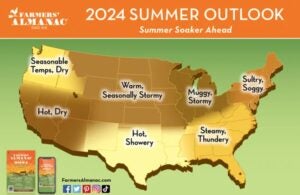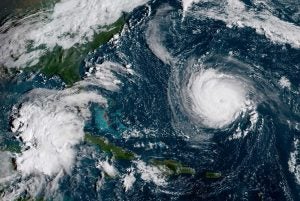Summer will officially arrive in North America on June 20, with the summer solstice — the earliest start in 128 years thanks to the Leap Year and exactly when the Sun reaches its northernmost point from the celestial equator.
While many people love summer with the time it urges us to spend outdoors, fishing, gardening, swimming, and more, it can be a nerve-wracking time for farmers. Between droughts, pests, water, weather events, and market uncertainties, the Farmers’ Almanac Summer Weather Forecast 2024 has likely piqued the interest of those in agriculture.
Kicking off with a Strawberry Moon and thunderstorms in the central U.S., June is predicted to be warm, humid, and thunderous in many, if not most areas of the country.

The muggy temperatures are predicted to bring a plethora of moisture and thunderstorms to most areas east of the Mississippi River. New England is on track to have yet another wet summer, and thunderstorms will be plentiful in the Great Lakes and Midwest region of the country.
For the Southeast states and the Mid-Atlantic region, summer’s soaking showers and steamy days could be a common occurrence. Meanwhile, Texas is anticipated to see hot temperatures and a stormier July than August.
The Almanac predicts that areas in the North Central region are expected to see a seesaw of summer temperatures with an overall warm season but with occasional cold Canadian air blowing in.
The Southwest will see hot, dry conditions for most of the summer. The Pacific Northwest will also be dry, but temperatures won’t be as extreme.
August and September: Hot and wet
According to the Farmers’ Almanac Summer Forecast 2024, August looks to be exceptionally wet and showery across the eastern two-thirds of the country. Gardeners in New England who saw a soggy summer season last year may want to plan “rain gardens” this year with plants that love a lot of water, such as marigolds, forget-me-nots, canna lilies, daylilies, irises, and hibiscus.
For those in the pathway of rain, prepare for an increase in certain insect populations!
The National Oceanic and Atmospheric Administration says there is a one-in-three chance that 2024 will be warmer than 2023, and a 99 percent chance it would rank among the five warmest on record!
»Related: Potential impacts of El Niño on crop production
Canadian forecast
To the north, many of Canada’s provinces will likely see rain during the summer months. Temperatures are slated to be warm and humid in most areas, not that unfamiliar from last summer.
Muggy, warm temperatures are predicted to be the norm in the eastern portions of the country, exception in Newfoundland and Labrador. These provinces are predicted to see a cloudy summer with many cool onshore breezes that will bring blow in a cooler than usual summer season.



